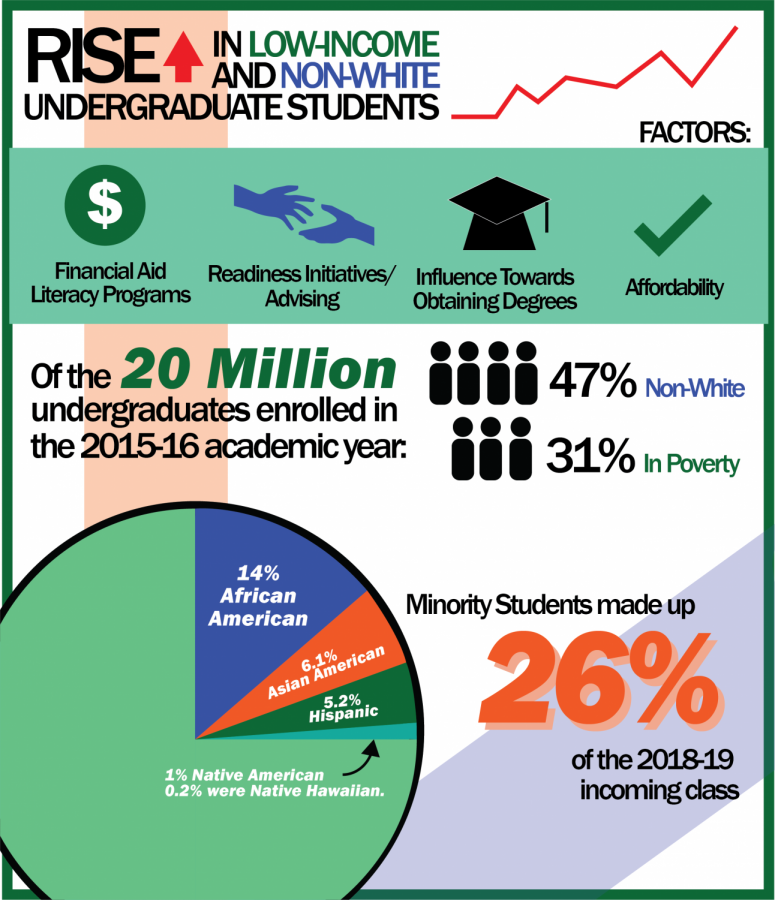Number of low-income and non-white undergraduate students is rising
College has universally been a source of opportunity, but now that opportunity may be becoming more accessible to struggling students.
A 2019 Pew Research analysis of National Center for Education Statistics data found the rising number of poor and non-white undergraduates “has been most pronounced in public two-year colleges and the least selective four-year colleges and universities.” Students are coming to college from low-income families and changing the demographic of college and university student economic statuses across the nation.
With 42% of full-time Oakland University undergraduate students receiving need-based financial aid in the 2016-2017 academic year, according to OU’s Fast Facts, incoming students are coming from different economic backgrounds.
Different factors make up why the number of low-income students is increasing at universities. Shane Lewis, director of Undergraduate Admissions, listed four reasons why: financial aid literacy programs showing students college is obtainable, college readiness initiatives such as the Advise Michigan College Core Adviser Group, increased influence toward obtaining degrees and colleges moving to make education more affordable.
“I think [students seeing college as obtainable] leads to overall higher enrollment,” Lewis said. “More students are going to be attending institutions and earning those degrees. I think what it means for institutions is we are then more likely to have more first-generation students, so we need to make sure as an institution that we have additional support services — that we are properly resourced to help these students be successful in college.”
Pew Research found that, of the about 20 million undergraduate students enrolled during the 2015-2016 academic year, 47% were non-white and 31% were in poverty. From the data, Pew said 20% of dependent undergraduates in 2016 were from families in poverty, a number at only 12% in 1996.
According to Pew, more low-income students are enrolling in post-secondary education than 20 years ago.
The OU Enrollment Report for fall 2018 said incoming freshmen classes are becoming more diverse, with minority students making up 26% of the 2018-2019 academic year incoming class. Of first-year students, 14% were African American, 6.1% Asian American, 5.2% Hispanic, 1% Native American and 0.2% were Native Hawaiian.
Lewis said he’s proud of the institutional need-based programs offered to struggling students at OU. With aid coming in the form of financial assistance to OU’s free application, Lewis emphasized OU being accessible to families in need is essential.
OU follows the Pew finding, with a 3% increase in students who qualify for Pell Grants in the past two years, though the number of low-income students is staying steady, Cindy Hermsen, Student Financial Services director, said. This increase in Pell Grant qualification may hint at OU’s efforts to give students a better initiative to enroll in college.
Hermsen said OU’s push for student success regardless of background is important in attracting more low-income and non-white students. The office has been increasing outreach programs and talking to students earlier about financial options.
“We are being proactive,” she said. “And we’re not waiting for the students to come to us — we’re going out there to them … We are out there outreaching to them, contacting them, telling them this is not a difficult process. This is very easy to do. We will help them all along the way. Our message is: ‘We are happy to help in any way we possibly can.’”
Hermsen encourages all students to fill out the FAFSA each year to ensure they are receiving the maximum aid for which they qualify.








